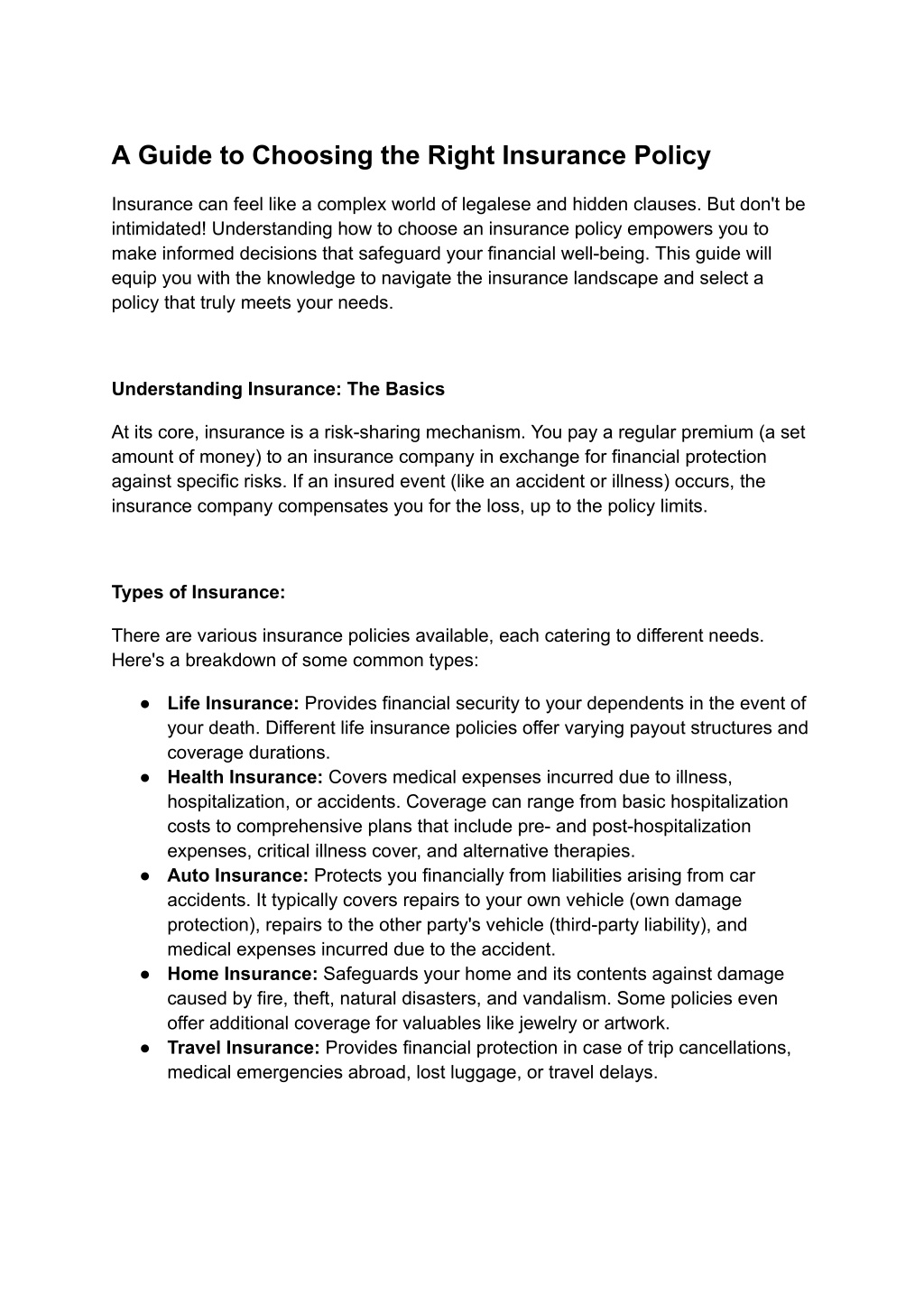
Insurance policy
Insurance can feel like a complex world of legalese and hidden clauses. But don't be intimidated! Understanding how to choose an insurance policy empowers you to make informed decisions that safeguard your financial well-being. This guide will equip you with the knowledge to navigate the insurance landscape and select a policy that truly meets your needs.
Download Presentation
Please find below an Image/Link to download the presentation.
The content on the website is provided AS IS for your information and personal use only. It may not be sold, licensed, or shared on other websites without obtaining consent from the author. Download presentation by click this link. If you encounter any issues during the download, it is possible that the publisher has removed the file from their server.
Presentation Transcript
A Guide to Choosing the Right Insurance Policy Insurance can feel like a complex world of legalese and hidden clauses. But don't be intimidated! Understanding how to choose an insurance policy empowers you to make informed decisions that safeguard your financial well-being. This guide will equip you with the knowledge to navigate the insurance landscape and select a policy that truly meets your needs. Understanding Insurance: The Basics At its core, insurance is a risk-sharing mechanism. You pay a regular premium (a set amount of money) to an insurance company in exchange for financial protection against specific risks. If an insured event (like an accident or illness) occurs, the insurance company compensates you for the loss, up to the policy limits. Types of Insurance: There are various insurance policies available, each catering to different needs. Here's a breakdown of some common types: Life Insurance: Provides financial security to your dependents in the event of your death. Different life insurance policies offer varying payout structures and coverage durations. Health Insurance: Covers medical expenses incurred due to illness, hospitalization, or accidents. Coverage can range from basic hospitalization costs to comprehensive plans that include pre- and post-hospitalization expenses, critical illness cover, and alternative therapies. Auto Insurance: Protects you financially from liabilities arising from car accidents. It typically covers repairs to your own vehicle (own damage protection), repairs to the other party's vehicle (third-party liability), and medical expenses incurred due to the accident. Home Insurance: Safeguards your home and its contents against damage caused by fire, theft, natural disasters, and vandalism. Some policies even offer additional coverage for valuables like jewelry or artwork. Travel Insurance: Provides financial protection in case of trip cancellations, medical emergencies abroad, lost luggage, or travel delays.
Choosing the Right Policy: A Step-by-Step Guide 1. Identify Your Needs: The first step is to determine what you need protection for. Consider your life stage, financial responsibilities, assets, and potential risks. Are you single or do you have dependents? Do you own a car or a home? Evaluating your specific needs will help you choose the right type of insurance. 2. Assess Your Risk Tolerance: How much financial risk are you comfortable taking on? Higher coverage amounts typically translate to higher premiums. Conversely, a lower coverage plan might leave you exposed if a significant event occurs. 3. Research and Compare Policies: Once you know what type of insurance you need, research different policies offered by various insurance providers. Compare coverage details, exclusions, claim settlement ratios (the percentage of claims approved by the insurer), and customer reviews. Online resources and insurance comparison websites can be valuable tools for this step. 4. Understand the Policy Wording: Don't be afraid to ask questions! Carefully read the policy document, focusing on key terms like coverage limits, exclusions, deductibles (the amount you pay out-of-pocket before the insurance kicks in), and claim settlement procedures. 5. Consider Renewability: Choose a policy that is renewable meaning you can continue the coverage after the initial term by paying the premium. This ensures long-term protection against unforeseen events. 6. Don't Just Focus on Price: While cost is a crucial factor, the cheapest policy might not always be the best option. Prioritize comprehensive coverage over a low premium to ensure you're adequately protected. 7. Review Regularly: Your needs and financial situation might change over time. Regularly review your insurance policies to ensure they remain aligned with your current circumstances. You might need to adjust coverage amounts, add new policies, or drop redundant ones. Additional Tips for Choosing an Insurance Policy: Get quotes from multiple insurers: Don't settle for the first quote you receive. Get quotes from several companies to compare options and find the best deal. Maintain a good credit history: A good credit score can qualify you for lower premiums. Consider bundling policies: Some insurance companies offer discounts when you purchase multiple policies from them (e.g., bundling home and auto insurance).
Seek professional advice: If you're unsure about which policy to choose, consult an insurance agent or broker. A qualified professional can assess your needs and recommend suitable options. Remember: Insurance is an investment in your financial security. Choosing the right policy empowers you to face unforeseen events with greater confidence. By following these steps and conducting thorough research, you can navigate the world of insurance and select a plan that provides optimal protection for you and your loved ones.
















































